The Intel 6th Gen Skylake Review: Core i7-6700K and i5-6600K Tested
by Ian Cutress on August 5, 2015 8:00 AM ESTWhat You Can Buy: Linux Performance
Built around several freely available benchmarks for Linux, Linux-Bench is a project spearheaded by Patrick at ServeTheHome to streamline about a dozen of these tests in a single neat package run via a set of three commands using an Ubuntu 11.04 LiveCD. These tests include fluid dynamics used by NASA, ray-tracing, OpenSSL, molecular modeling, and a scalable data structure server for web deployments. We run Linux-Bench and have chosen to report a select few of the tests that rely on CPU and DRAM speed.
C-Ray: link
C-Ray is a simple ray-tracing program that focuses almost exclusively on processor performance rather than DRAM access. The test in Linux-Bench renders a heavy complex scene offering a large scalable scenario.
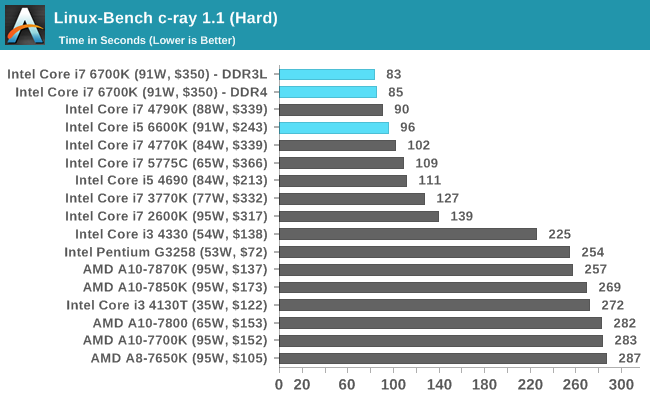
NAMD, Scalable Molecular Dynamics: link
Developed by the Theoretical and Computational Biophysics Group at the University of Illinois at Urbana-Champaign, NAMD is a set of parallel molecular dynamics codes for extreme parallelization up to and beyond 200,000 cores. The reference paper detailing NAMD has over 4000 citations, and our testing runs a small simulation where the calculation steps per unit time is the output vector.
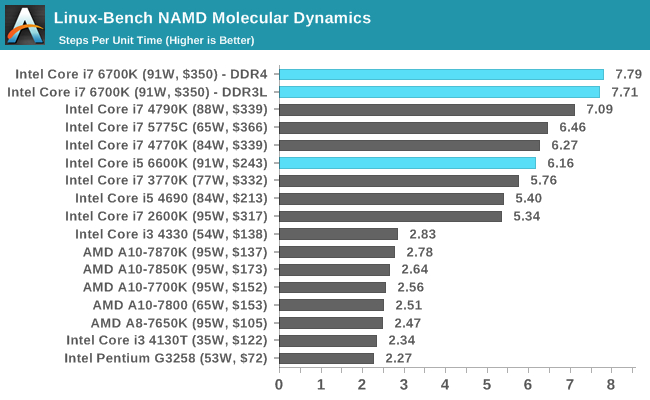
NPB, Fluid Dynamics: link
Aside from LINPACK, there are many other ways to benchmark supercomputers in terms of how effective they are for various types of mathematical processes. The NAS Parallel Benchmarks (NPB) are a set of small programs originally designed for NASA to test their supercomputers in terms of fluid dynamics simulations, useful for airflow reactions and design.
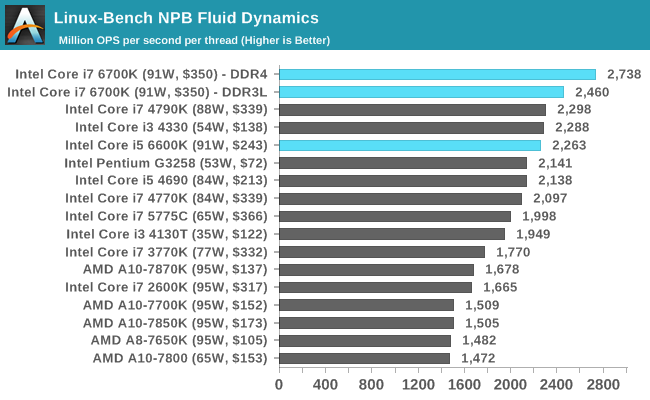
Redis: link
Many of the online applications rely on key-value caches and data structure servers to operate. Redis is an open-source, scalable web technology with a b developer base, but also relies heavily on memory bandwidth as well as CPU performance.
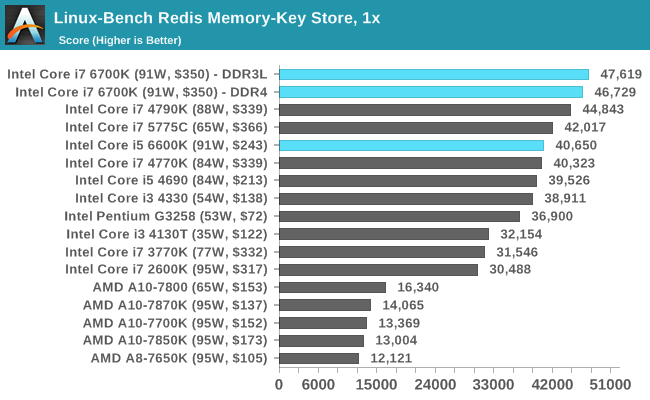
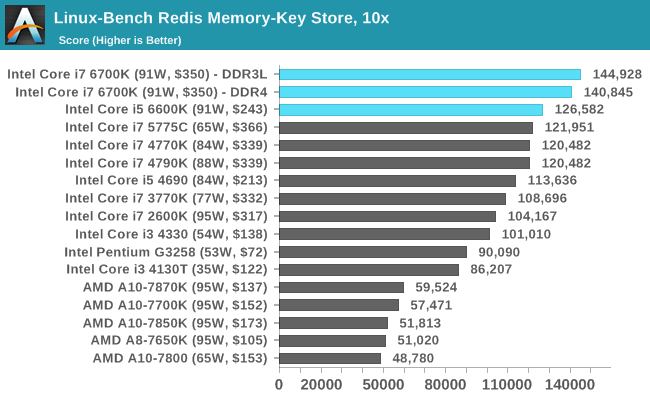
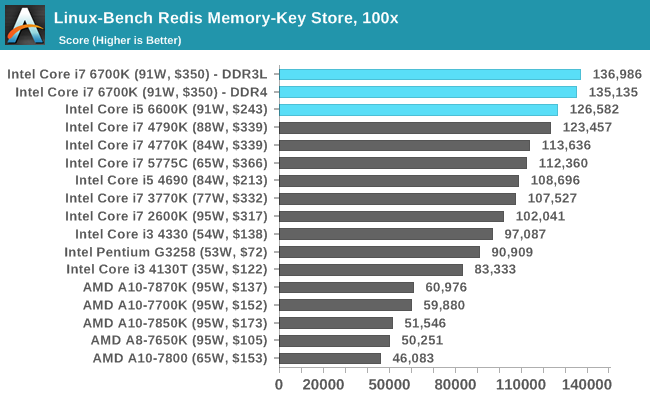










477 Comments
View All Comments
SkOrPn - Tuesday, December 13, 2016 - link
Well if you were paying attention to AMD news today, maybe you partially got your answer finally. Jim Keller yet again to the rescue. Ryzen up and take note... AMD is back...CaedenV - Wednesday, August 5, 2015 - link
Agreed, seems like the only way to get a real performance boost is to up the core count rather than waiting for dramatically more powerful single-core parts to hit the market.kmmatney - Wednesday, August 5, 2015 - link
If you have an overclocked SandyBridge, it seems like a lot of money to spend (new motherboard and memory) for a 30% gain in speed. I personally like to upgrade my GPU and CPU when I can get close the double the performance of the previous hardware. It's a nice improvement here, but nothing earth=shattering - especially considering you need a new motherboard and memory.Midwayman - Wednesday, August 5, 2015 - link
And right as dx12 is hitting as well. That sandy bridge may live a couple more generations if dx12 lives up to the hype.freaqiedude - Wednesday, August 5, 2015 - link
agreed I really don't see the point of spending money for a 30% speedbump in general, (as its not that much) when the benefit in games is barely a few percent, and my other workloads are fast enough as is.If Intel would release a mainstream hexa/octa core I would be all over that, as the things I do that are heavy are all SIMD and thus fully multithreaded, but I can't justify a new pc for 25% extra performance in some area's. with CPU performance becoming less and less relevant for games that atleast is no reason for me to upgrade...
Xenonite - Thursday, August 6, 2015 - link
"If Intel would release a mainstream hexa/octa core I would be all over that, as the things I do that are heavy are all SIMD and thus fully multithreaded, but I can't justify a new pc for 25% extra performance in some area's."SIMD actually has absolutely nothing to do with multithreading. SIMD refers to instruction-level parallellism, and all that has to be done to make use of it, for a well-coded app, is to recompile with the appropriate compiler flag. If the apps you are interested in have indeed been SIMD optimised, then the new AVX and AVX2 instructions have the potential to DOUBLE your CPU performance. Even if your application has been carefully designed with multi-threading in mind (which very few developers can, let alone are willing to, do) the move from a quad core to a hexa core CPU will yield a best-case performance increase of less than 50%, which is less than half what AVX and AVX2 brings to the table (with AVX-512 having the potential to again provide double the performance of AVX/AVX2).
Unfortunately it seems that almost all developers simply refuse to support the new AVX instructions, with most apps being compiled for >10 year old SSE or SSE2 processors.
If someone actually tried, these new processors (actually Haswell and Broadwell too) could easily provide double the performance of Sandy Bridge on integer workloads. When compared to the 900-series Nehalem-based CPUs, the increase would be even greater and applicable to all workloads (integer and floating point).
boeush - Thursday, August 6, 2015 - link
Right, and wrong. SIMD are vector based calculations. Most code and algorithms do not involve vector math (whether FP or integer). So compiling with or without appropriate switches will not make much of a difference for the vast majority of programs. That's not to say that certain specialized scenarios can't benefit - but even then you still run into a SIMD version of Amdahl's Law, with speedup being strictly limited to the fraction of the code (and overall CPU time spent) that is vectorizable in the first place. Ironically, some of the best vectorizable scenarios are also embarrassingly parallel and suitable to offloading on the GPU (e.g. via OpenCL, or via 3D graphics APIs and programmable shaders) - so with that option now widely available, technologically mature, and performant well beyond any CPU's capability, the practical utility of SSE/AVX is diminished even further. Then there is the fact that a compiler is not really intelligent enough to automatically rewrite your code for you to take good advantage of AVX; you'd actually have to code/build against hand-optimized AVX-centric libraries in the first place. And lastly, AVX 512 is available only on Xeons (Knights Landing Phi and Skylake) so no developer targeting the consumer base can take advantage of AVX 512.Gonemad - Wednesday, August 5, 2015 - link
I'm running an i7 920 and was asking myself the same thing, since I'm getting near 60-ish FPS on GTA 5 with everything on at 1080p (more like 1920 x 1200), running with a R9 280. It seems the CPU would be holding the GFX card back, but not on GTA 5.Warcraft - who could have guessed - is getting abysmal 30 FPS just standing still in the Garrison. However, system resources shows GFX card is being pushed, while the CPU barely needs to move.
I was thinking perhaps the multicore incompatibility on Warcraft would be an issue, but then again the evidence I have shows otherwise. On the other hand, GTA 5, that was created in the multicore era, runs smoothly.
Either I have an aberrant system, or some i7 920 era benchmarks could help me understand what exactly do I need to upgrade. Even specific Warcraft behaviour on benchmarks could help me, but I couldn't find any good decisive benchmarks on this Blizzard title... not recently.
Samus - Wednesday, August 5, 2015 - link
The problem now with nehalem and the first gen i7 in general isn't the CPU, but the x58 chipset and its outdated PCI express bus and quickpath creating a bottleneck. The triple channel memory controller went mostly unsaturated because of the other chipset bottlenecks which is why it was dropped and (mostly) never reintroduced outside of enthusiast x99 quad channel interface.For certain applications the i7 920 is, amazingly, still competitive today, but gaming is not one of them. An SLI GTX 570 configuration saturates the bus, I found out first hand that is about the most you can get out of the platform.
D. Lister - Thursday, August 6, 2015 - link
Well said. The i7 9xx series had a good run, but now, as an enthusiast/gamer in '15, you wouldn't want to go any lower than Sandy Bridge.